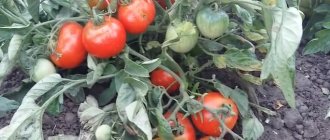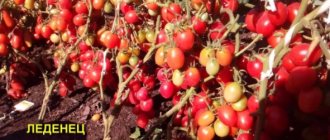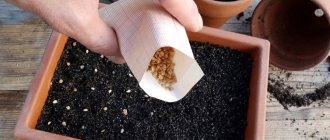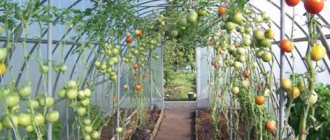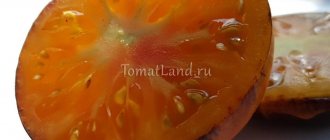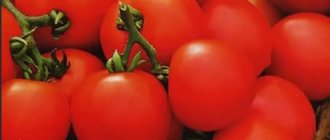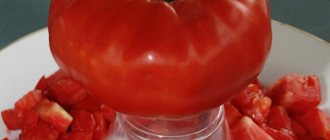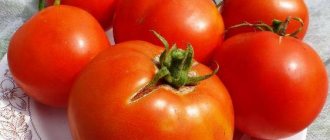| Ripening period: | early ripening |
| Shape, weight of fruits: | round, 20-25 grams |
| Bush type: | indeterminate |
| Growing regions: | southern, central |
| Productivity: | 7 kg per sq.m. |
The Magic Harp tomato is a godsend for gardeners in the central and southern parts of the country. This yellow-fruited cluster hybrid is famous not only for its good yield and quality of tomatoes, but also for its colorful appearance. The variety is heat-loving, created for cultivation in closed greenhouse structures. They are grown in open beds only in regions with a mild climate.
Description and characteristics of the hybrid
Tomato Magic Harp f1 belongs to indeterminate hybrids, which indicates the tallness of the stem (reaches 1.5-2 meters).
It is characterized by early ripening: the period from germination to the beginning of fruiting is 90-95 days. After this period, the first fruit clusters filled with beautiful ripe tomatoes are obtained (shown in the photo).
The yield is about 7 kg per square meter. or 1.5-2 kg per bush, which is considered a good indicator of fruiting.
The bushes are covered with fruit clusters, 7-8 pieces per plant. The mass of such a bunch is 200 grams, the tomatoes themselves are small, one piece weighs 25-30 grams. Tomatoes are collected in whole bunches.
Description of the Magic Harp variety includes characteristics of the fruit. Cocktail tomatoes are yellow and orange. The taste is sweet, fruity, the tomatoes themselves are juicy. Due to their high taste properties, it is recommended to be consumed fresh, but they are also widely used in canning. These pickles turn out beautiful and very appetizing.
Yellow tomatoes contain the antioxidant beta-carotene and are considered hypoallergenic. Therefore, the Magic Harp is suitable for people suffering from intolerance to red pigment.
Daily consumption of 200 grams of fruits of the described variety is the prevention of cancer pathologies.
Features of cultivation and storage
The tomato is intended for growing in greenhouses. Seedlings are transplanted into beds at the age of 55-60 days. The soil is fertilized in advance by adding the following per 1 m2:
- compost 5 kg;
- superphosphate 30 g;
- potassium salt 15 g;
- nitrogen fertilizers 20g.
3 bushes are planted per 1 m2. The distance between the holes is 50-60 cm, the row spacing is 70 cm.
How to grow a hybrid:
- form a tomato into 2-3 stems, leaving no more than 10 bunches of cherry tomatoes;
- pinching is carried out once every 10 days;
- feed 1-2 times a month, it is necessary to apply fertilizers during flowering, during flowering, and during ripening;
- water at the root with warm water, the norm for 1 bush is 5 l;
- loosen to avoid crusts;
- mulch with a layer of 8 cm; straw and sawdust are used for mulch.
Ripe cherry tomatoes are stored no longer than 1.5-2 weeks. Choose dark, cool rooms for storage.
Growing seedlings
Since the Magic Harp tomato is a hybrid, you cannot use seeds from the previous harvest. To grow seedlings, seed material is purchased at the store.
Sowed in the third decade of February or early March. The soil must be fertile and loose. The seeds are compacted into holes 1.5 cm deep, then the container is covered with film and kept warm.
With the emergence of seedlings, the polyethylene is removed and the container is moved to a lighted place. If there is a lack of sunlight, use a phytolamp.
As soon as a pair of true leaves have formed, a pick is made.
10-14 days before the seedlings are finally moved into the ground, the hardening procedure is practiced. The container with plants is exposed to the open air for a quarter of an hour, increasing the time interval daily.
Landing
F1 hybrid seeds are purchased only from licensed seed stores; it is not recommended to use seeds from the previous harvest to avoid loss of quality of the original crop. Seeds for seedlings are sown in the first ten days of March. The earth mixture can be purchased at the store or used as follows: 1 part sand, 1 part humus, 1 part garden soil.
The seeding depth is up to 1.5 cm, then the soil is lightly compacted, covering the boxes with glass or film and placed in a warm place until germination. You need to make sure that the top of the soil does not dry out. Sowing and growing seedlings is not difficult even for beginner gardeners.
Features of caring for seedlings
After the shoots appear, the film is removed, the boxes are placed in a lighted place, and if necessary, the seedlings are illuminated. They also monitor the soil moisture and water if necessary. After the first pair of true leaves appear, the seedlings dive into pots or cups.
If the young growth has managed to stretch out, you can, when planting plants, deepen the stems into the ground right up to the leaves. A couple of weeks before planting seedlings in open ground, the young plants must be hardened off by placing them on the balcony, gradually increasing their time spent in the open air. The main thing for seedlings is compliance with light and thermal conditions.
Planting in open ground
Grown seedlings are planted approximately 2 months after germination, protecting them from dangerous return frosts. Seedlings are planted in calm weather, no more than 4 plants per 1 square meter. m. Be sure to deepen it to the first leaves, avoiding burying leaf blades in the soil.
Transplantation is carried out in prepared holes, having prepared a fertilizer mixture. Water generously with warm water so that the transplanted plants take root better. During this period, you need to carefully monitor the weather forecast, in case of danger of night frosts, cover with buckets or other covering materials.
Planting in the ground and caring for tomatoes
The seedlings are transferred to the beds 65 days from the date of sowing the seeds. Planting is carried out in good calm weather. To ensure that the bushes have enough nutrients and moisture, place no more than three pieces per m2.
The soil is pre-prepared: moistened, saturated with organic matter, nitrogen and potassium fertilizers.
Further care for the Magic Harp tomato consists of the following procedures:
- Watering. It is carried out with warm, settled water once every five days, moisturize at the root. One plant requires five liters of liquid. In greenhouses, drip irrigation is recommended; such irrigation is a prevention of late blight.
- Stepsonning. To prevent the green part of the bush from growing and absorbing large amounts of nutrients, regular pinching is required. Remove excess branches at least once a week.
- Garter. Since the Magic Harp stretches up to two meters, it is necessary to fix the stem to a support. Tie it up as it grows.
- Formation. It is optimal to grow a bush with one or two stems. This measure makes it possible to obtain a good quality harvest.
- Feeding. The hybrid variety requires mineral fertilizers. To meet the needs of plants, it is better to use complex fertilizers. Apply during flowering, ovary and fruiting periods.
Features of growing tomatoes Magic Harp
sowing the seeds of this tomato for seedlings 60-65 days before the intended planting in the ground. Seedlings dive at the stage of two true leaves. When planting seedlings in a permanent place per 1 sq. It is recommended to place up to 4 plants per meter of land.
Further care for tomatoes consists of timely watering, fertilizing with complex mineral fertilizer, pinching and preventive measures to protect against diseases and pests.
Diseases and pests of the hybrid
Magic Harp F1 tomatoes are characterized by natural resistance to typical nightshade pathologies. They resist tobacco mosaic, cladosporiosis, verticillium, and fusarium wilt.
To prevent the development of phytospores, carry out ventilation and periodically remove damaged or yellowed leaves.
You can cope with an existing disease by spraying with Bordeaux mixture or the drug Fitosporin.
Among the insect pests on plants are aphids and whiteflies. To drive away parasites, plants are irrigated with Karate, Confidor, Decis.
Basic growing rules
This variety can be grown in open ground, but only in regions with a moderately warm climate.
In cool summer conditions and lack of sunlight, it is recommended to grow plants in a greenhouse to avoid loss of yield. Even with no experience, you can successfully grow Marfa F1 tomatoes and get a good harvest. But if you follow a few of the rules and recommendations described below, the plant productivity will increase several times. Let's take a closer look at the main features of growing Marfa F1 tomatoes.
Growing seedlings
The process of growing Marfa F1 tomatoes begins with proper planting of seeds and caring for seedlings.
The seeds of this variety have good germination, but for the best results it is recommended to carry out several additional steps to prepare them:
- warm the seeds on a radiator for several days, placing them in a small fabric bag;
- disinfect the seeds using a weak solution of potassium permanganate;
- treat planting material with growth stimulants (for example, Epin);
- Dry the seeds slightly at room temperature before planting.
Read more about when and how to plant tomato seedlings correctly.
The soil for growing seedlings must be loose and contain the nutrients necessary for the sprouts.
You can use a ready-made store-bought substrate or prepare the soil yourself from the following components:
- turf land;
- garden soil;
- humus;
- river sand.
Let's look at step-by-step instructions for planting seeds and rules for growing tomato seedlings:
- Make small holes in the soil surface about 1–1.5 cm deep.
- Place the tomato seeds into the prepared holes and sprinkle with a small layer of peat.
- Lightly spray the soil with the seeds with warm water and cover with film. Keep the container in a room with a temperature of about +25 °C.
- After the seeds sprout green shoots, remove the film. Place the seedlings in a well-lit place with an air temperature of about +16°C for about 1 week. Then increase the air temperature in the room with the seedlings to +22°C.
- When a couple of green leaves appear on the seedlings, pick the seedlings. Apply complex liquid fertilizer.
- As the top layer of soil dries, moderately water the sprouts with warm water from a watering can. Grow seedlings away from drafts.
Did you know? The leader in growing tomatoes is China. About 16% of the world's total tomatoes are produced here.
Preparing the soil for planting seedlings
It is not recommended to plant tomatoes two years in a row in the same place - this will lead to soil depletion and a decrease in yield. The area for growing plants needs to be changed every year. And in order for the seedlings to take root well on the site and produce a high yield, the soil must first be prepared.
This procedure consists of several stages:
- in the fall, dig up the soil and then pour it with a warm aqueous solution of copper sulfate (1 tbsp of the substance is needed for 10 liters of water);
- in the spring, add organic fertilizer consisting of peat, humus and sawdust with the addition of superphosphate;
- 10 days before planting the seedlings, dig up the area again and treat the ground with a lime solution;
- To disinfect the soil, pour it with a hot solution of potassium permanganate.
Technology of planting seedlings
Young tomato seedlings are usually planted in a greenhouse when the sprouts reach the age of 60–65 days. At this time, the plants have already formed 3-4 pairs of green leaves and at least one flower cluster. Planting of seedlings in open ground is carried out a little later and only after the soil has warmed up sufficiently.
Step-by-step instructions for transplanting seedlings are presented below:
- Dig holes in the soil about 8 cm deep. Place nitrogenous fertilizers at the bottom of the hole.
- Carefully remove the young sprout from the individual container along with the earthen lump.
- Place the seedling in the hole and cover its roots with soil. Lightly compact the soil around the sprout stem.
- If the soil is not moist enough, you can water the seedling at the root with a small amount of warm water.
Important! Planting of seedlings is carried out according to the 50x40 scheme; no more than 3 plants can be placed per 1 m²
Advantages and disadvantages
The variety has many positive qualities. Its advantages include:
- fruits are rich in antioxidants and other beneficial substances;
- suitable for allergy sufferers;
- resistant to nightshade pathologies;
- early formation and ripening of tomatoes;
- high productivity;
- interesting fruity taste.
In addition to its positive properties, the Magic Harp has several negative aspects:
- needs regular stepsoning;
- active vegetation.
Description of the variety
The tomato is also considered especially successful due to its decorative properties. When planting tomatoes on a plot, a rare summer resident expects to decorate the garden at the same time. But bunch-shaped tomatoes easily combine decorative and food functions. Moreover, even dishes become more attractive, because tomatoes are small and can be placed without cutting them. Bright orange glossy fruits look appetizing both in salads and in jars.
Attention! You can preserve tomatoes whole, turning the preparations into a work of art.
General characteristics:
- the height of the bush generally reaches 2 m, the leaves do not differ in shape from other standard varieties;
- the fruits are arranged like a vine with clusters, the number can reach 18 pieces. on each hand;
- the size of the tomatoes does not exceed 5 cm in diameter, weight up to 25 g, color bright orange with gloss.
According to ripening time | By type of growth | By type of use | By growing method | Fruit weight (g) | Productivity (kg/m2) | Ripe fruit color | Fetal characteristics |
| Early ripe | Indeterminant | Universal | For unheated glass and film greenhouses | 20-25 | 7 – 10 | Yellow-orange | Round, dense, glossy. The taste is sweet. |
Similar varieties and hybrids
Magic Harp tomatoes are not the only variety that produces a bountiful harvest of small, sweet fruits. There are cherry tomatoes that are similar in characteristics and descriptions:
- The necklace is yellow. A vigorous hybrid with an average fruiting period, the first tomatoes are formed 115 days after germination. It withstands hot and dry weather and resists infectious pathologies. The tomatoes weigh 6 grams, are bright yellow in color, and are located on the clusters. If you pick tomatoes together with a bunch, the harvest can be stored for one and a half months. At the same time, the fruits remain sweet and juicy.
- Cherry yellow. Refers to early-ripening crops; maturity of tomatoes is observed three months after the formation of seedlings. The bushes are indeterminate, slightly spreading. Tomatoes are small, smooth, oval in shape. Yellow color. The yield is average, 1-2 kg per bush. The hybrid suffers from late blight, tobacco mosaic, and cladosporiosis. The tomato is intended for planting in open ground, but cultivation in greenhouse conditions is also acceptable.
- Orange caviar. Early hybrid of determinate type. Fruits 95 days after germination. The color of the tomatoes is bright, yellow-orange, weight 10-15 grams. The shape is round. From one square meter they get 5-6 kg of harvest, which indicates productive fruiting. Storage is short and requires prompt processing. Plants do not tolerate cold well, so it is recommended to plant them in a greenhouse or outdoors in a favorable climate.
- 4. Yellow caramel. The variety is cultivated in all corners of the country. Depending on climatic conditions, they are grown in a greenhouse or in open beds. The hybrid is considered early ripening, high-yielding, the ripening period is 100 days. The tomato is yellow, smooth, weighing about 40 grams. The bush is long, stretches up to two meters. Resistant to infectious pathologies.
- Sugar bunch F1 yellow. Determinate tomato, early ripening (83-85 days). Ripe tomatoes are bright yellow in color. The shape is round, there is slight ribbing, the weight of one fruit is 15-20 grams. The hybrid is juicy and sweet. A highly productive variety, in greenhouse conditions they get 12 kg of yield from one square meter. Resistant to typical nightshade pathologies.
All of the varieties listed are good for fresh consumption and go well with other vegetables. Cherries are also used in canning, while the fruits retain their sweetness. Whole tomatoes are used for pickling.
Caring for indeterminate tomatoes
Let's look at the main stages of caring for tomatoes.
- Garter,
- stepsoning,
- watering,
- weeding and loosening the soil,
- fertilizer.
As they grow, the bushes are tied to the crossbar. The lower stepsons break off and a bush of 1 stem is formed. Leaves also need to be removed gradually, 1 bottom leaf per week, some gardeners remove them completely, others only 2-3 bottom leaves. Everyone does what is convenient for them.
During the season, tomatoes are fed 3 times with organic and mineral fertilizers . Practice shows that fertilized bushes produce a higher and tastier harvest.
Watering in the greenhouse is done at the root after planting as the soil dries; in dry and hot weather this procedure is carried out up to 2 times a day. It is important not to over-moisten the soil, otherwise the roots will rot and the plants will die.
Harvesting of the indeterminate variety occurs before the frosts, and in mid-August you need to pinch off the tops so that the remaining fruits on them have time to ripen before frost. With such simple care for tomatoes, you will get a high yield of beautiful clusters of tasty fruits.
Growing rules
The choice of cultivation method is determined independently: a favorable climate and fertile soil are the basis for cultivating the Golden Fleece variety in open ground. In the northern regions, heated rooms are preferred.
Planting seedlings
Seed material is collected independently or purchased from producers. To do this, the ripe fruit is washed and patted down well, then left in this state for 2–3 days.
After the time has passed, the Golden Fleece tomato seeds are removed and washed in warm water. After this, they must be dried and packaged in a paper envelope. Store raw materials in a closet until spring.
A month before planting, they are calibrated, removing damaged seeds, and treated with the growth stimulator Immunocytophyte or Kornevin. To do this, place tomato seeds in the solution for 6 hours. At the end of the procedure, they are dried.
5 days before planting, the seed material of the Golden Fleece tomato is hardened. To do this, they are left on the bottom shelf of the refrigerator. Keep for 30 minutes, then increase the time to several hours.
Important! At the end of the hardening procedure, the seeds must be stored in a warm room. The soil for planting is prepared in advance: humus, peat and soil are mixed in equal parts, add 0.5 tbsp.
ash. Disinfect the soil with solutions of fungicides or potassium permanganate. Calcination of the soil in an oven is allowed (temperature up to 10 ºС). The prepared soil is distributed into containers: plastic dishes, special containers or peat pots
The soil for planting is prepared in advance: humus, peat and soil are mixed in equal parts, and 0.5 tbsp is added. ash. Disinfect the soil with solutions of fungicides or potassium permanganate. Calcination of the soil in an oven is allowed (temperature up to 10 ºС). The prepared soil is distributed into containers: plastic dishes, special containers or peat pots.
One of the main requirements is the presence of drainage holes.
Planting seed material of the Golden Fleece variety is carried out as follows: it is placed in a container with soil and sprinkled with soil on top and moistened well. At the end of the procedure, the container is covered with film or glass.
Important! The optimal time for planting the Golden Fleece tomato is mid-March and early April. The region and climate characteristics are taken into account
Watering seedlings involves timely watering and loosening the soil. She needs to provide sufficient access to sunlight and prevent drafts.
Transfer
When choosing a location on a plot, it should be taken into account that the Golden Fleece tomato should not be planted in the place of predecessors such as pepper and other nightshades. The variety feels great in the garden where legumes, herbs and cucumbers previously grew.
Before transferring a tomato seedling into the ground, the soil is cleared of weeds and dug up. The optimal time for transplanting tomatoes is the end of May or the beginning of June.
Important! Planting scheme: leaves 70 cm between rows and 35 cm between seedlings. Water is poured into the prepared hole and fertilizer containing nitrogen or phosphorus is added.
The seedling is lowered into the hole and sprinkled with soil on top. If the danger of frost remains, the plant is covered with material
Water is poured into the prepared hole and fertilizer containing nitrogen or phosphorus is added. The seedling is lowered into the hole and sprinkled with soil on top. If the danger of frost remains, the plant is covered with material.
Caring for the Golden Fleece variety consists of following the rules of agricultural technology: moistening the soil as it dries, loosening and timely weeding. It is recommended to hill up the bush.
Although this variety does not require staking, supports are built to avoid bending the bush to the ground under the weight of the tomatoes. For this purpose, trellises and metal structures are used.
Fertilizing is carried out three times during the growing season. For this, mullein or bird droppings are used (proportions 1:10). It is recommended not to neglect mineral fertilizers containing phosphorus and potassium.
